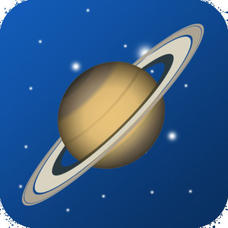Have you ever looked up at the night sky and wondered what constellation you were seeing or whether that bright object was a star or a planet? Are you searching for the best tilt-to-view constellation and planet app that money can't buy? Find rising and setting times for the sun, moon, and planets, and more.
Additional Tags
App Overview
While not as detailed as some of the paid apps, Planets has 2-D and 3-D modes, location services to help you identify exactly which constellations and planets are visible to you, and gives data about each major planet as it relates to Earth, including size, distance from the sun, atmospheric composition, day and year length, number and names of moons, and a link to a Wikipedia page about that planet; the link to Wikipedia is the only feature that requires 3G or Wi-Fi connectivity.
Sky 2-D Features:
- Sun and moon rising and setting times
- Compass (on navigation-enabled devices)
Sky 3-D Features:
- Real-time sky data based on your location
- Button at top left toggles between drag-to-view and tilt-to-view features (for compass-enabled devices)
- Planetarium view of constellations and planets
- View different light spectrums (visible, x-ray, gamma ray, infrared, microwave, etc.)
Globe Features:
- Cloudless satellite 3-D image of Earth rotating
- Real-time day and night on Earth; see which half of Earth is currently facing the sun
- View Earth's moon and each of the 8 major planets' 3-D images, as well as rotation speeds
Visibility Features:
- Tap moon to see current phase
- Tap planets to get data (rotation, revolution, mass, moons, etc.)
- Times that planets will be visible based on your location
Options Features:
- Enable/disable automatic location
- Change location, date, or time
- Link to Planets tutorial video
- Link to "Why Pluto is Not a Planet" video
Instructional Ideas
- Groups can each research one planet each and make a poster comparing it to Earth's radius, mass, day and year length, and AUs from the sun
- When studying stars, your young astronomers can determine which constellations will be visible that night
- Create drawings of the objects represented in constellations based on the outlines
- Discuss the meaning of day and year length using other planets' data
- Use light spectrum views when teaching about light
- When teaching about day and night in class, show direction of Earth's rotation, as well as real-time day and night view from Globe mode
Classroom Considerations
Planets is a great introduction to the solar system, but the data is quite limited. You can see star names, yet cannot access any data about them, there is no search function, and the planetary information is only at a very basic level. It would be a great way to allow learners to have a free app on their own devices, but if you want to go in-depth, you may need some additional apps.
If you are in tilt mode and move the view manually, you will need to tap the button in the upper left to get back to planetarium view.
Pros
- Free
- Location-based
- Most features do not require Wi-fi connectivity
Cons
- Limited information
- No star data
- Cannot click on planets in 3-D mode to access data


